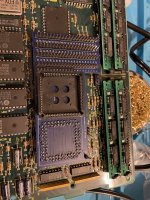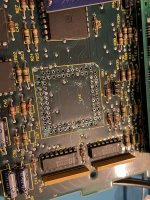maceffects
Well-known member
I’ve soldered together the breakout board it was quite tedious and I put a bit too much solder in the extension pins as I couldn’t get them to stay very well. I know everything looks like a very amateurish job but it works. I could have slowed things down to look better but had limited time.
Unfortunately, I couldn’t clear out all the PLCC pins and solder on the logic board. I was starting to damage the board with heat so I gave up for now. Despite having a Hakko desoldering gun, it was an unpleasant process.


Unfortunately, I couldn’t clear out all the PLCC pins and solder on the logic board. I was starting to damage the board with heat so I gave up for now. Despite having a Hakko desoldering gun, it was an unpleasant process.


